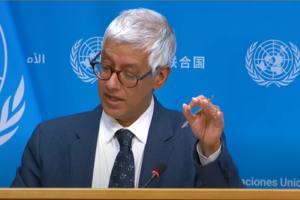When Two Parties Aren’t Enough

Over the last several months of public opinion polls, the American people have made it clear how little enthusiasm they have for a Joe Biden-Donald Trump rematch. So one would assume that finding a third alternative who could defeat the two probable party nominees shouldn’t be that difficult. One would be wrong.
Deciding that there should be a third party is the easy part. Where it gets harder is deciding what that new party should be and who it should represent. The bipartisan No Labels group is the most recent entity to attempt to fill this space, propelled by widespread voter distaste for the likely presidential general election contest between Biden and Trump.
For over a decade, No Labels has been attracting deep-pocketed supporters who have sought a counterweight to the growing polarization in American politics and using those funds to promote cooperative legislative efforts across party lines in Congress. Now they’re looking to enter the presidential fray and have begun efforts to field a fusion ticket with a Republican and Democratic candidate running together. They have tapped their donor base for tens of millions of dollars and have begun to qualify their party for ballot access in key states.
But unlike No Labels’ efforts on Capitol Hill, where they are regarded as a harmless sideshow that occasionally can package votes for centrist legislation, the group’s foray into presidential politics has set off all sorts of alarm bells. Democrats are especially unhappy, as they look at polling that shows a third-party candidate drawing more votes from Biden than from Trump and potentially putting the Republican back in the White House. So No Labels’ leaders have been forced to partially backtrack, promising that they would not move forward with a ticket of their own if it appeared by next spring that their candidate would be a spoiler that would cost Biden re-election.
These types of populist movements have been around for almost as long as the two parties themselves. They have never elected a president, nor come particularly close, as Ross Perot’s 19 percent of the popular vote in 1992 and George Wallace’s 45 electoral votes in 1968 represent their high-water mark in the primary era. Go back further, and Strom Thurmond’s Dixiecrats in 1948 and Teddy Roosevelt’s Bull Moose Party in 1912 (which actually finished second to the eventual Democratic victor) had somewhat greater impact on the eventual outcome.
The challenge for No Labels, like the third party movements that have preceded them, is that while there is deep unhappiness with the two parties, there is no agreement whatsoever on what the alternative should look like. Every frustrated voter envisions a party and candidate whose ideological makeup and policy goals mirror their own. But when a flesh-and-blood politician emerges with tangible issue positions, it’s impossible to satisfy the wide range of often contradictory demands that dissatisfied liberals, conservatives, and various types of centrists all desire. As those political dreams are inevitably dashed, most of the restless voters return to their own parties. And the challengers to the Dem/Rep duopoly wither away.
But the even greater obstacle for those would-be disruptors is a basic misunderstanding of why a voter would choose to leave the two major parties in the first place. There is a common misperception that independent voters are ideologically moderate, who find the Democratic Party to be unacceptably liberal and Republicans to veer too far rightward. But there is extensive research that shows that most independents are ideologically indistinguishable from traditional partisans. Rather, what separates them is not liberal/conservative leanings but rather a profound distaste for conventional politics and politicians.
Think back to the third-party presidential candidates mentioned earlier in this column. Whether segregationists like Thurmond and Wallace, a reformer like Roosevelt, or an iconoclast like Perot, each of these men channeled an intense populist anger that Americans harbored toward the ruling political classes. But broad grassroots resentments are rarely able to transcend tangible policy differences, and so each of these challengers came up far short.
This type of middle-finger politics is the defining characteristic of independent and third-party campaigns, and the cerebral and collaborative approach employed by No Labels in the past may be somewhat of a mismatch for the emotional needs of a bloodthirsty electorate. Americans who are underwhelmed by Biden and disgusted by Trump are likely to be looking for something more than sensible centrism.
Want to talk about this topic more? Join Dan for his webinar "Politics In The Time of Coronavirus." Or read more of Dan’s writing at: www.danschnurpolitics.com.
Dan Schnur is a Professor at the University of California – Berkeley, Pepperdine University, and the University of Southern California, where he teaches courses in politics, communications and leadership. Dan is a No Party Preference voter, but previously worked on four presidential and three gubernatorial campaigns, serving as the national Director of Communications for the 2000 presidential campaign of U.S. Senator John McCain and the chief media spokesman for California Governor Pete Wilson. He has a Center bias.
This piece was reviewed and edited by Isaiah Anthony, Deputy Blog Editor (Center bias).


May 16th, 2024

May 16th, 2024

May 16th, 2024